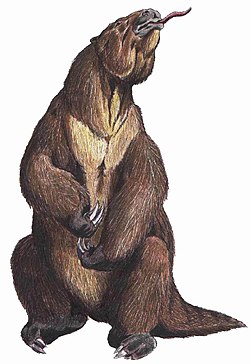This article relies largely or entirely on a single source .(April 2022) |
| Promegatherium | |
|---|---|
 | |
| Promegatherium nanum and Nesodon | |
| Scientific classification | |
| Domain: | Eukaryota |
| Kingdom: | Animalia |
| Phylum: | Chordata |
| Class: | Mammalia |
| Order: | Pilosa |
| Superfamily: | Megatherioidea |
| Clade: | † Megatheria |
| Family: | † Megatheriidae |
| Subfamily: | † Megatheriinae |
| Genus: | † Promegatherium Ameghino, 1883 |
| Species | |
†P. cabreri | |
Promegatherium ("before Megatherium ") is a genus of prehistoric xenarthrans that lived in Argentina, during the Late Miocene. This genus is regarded as closely related to the later, and more famous genus, Megatherium, hence the reference in the name. The first specimens of Promegatherium were originally described by the biologist Florentino Ameghino in 1883.
Fossils of Promegatherium have been found in the Ituzaingó Formation in Argentina. [1]

